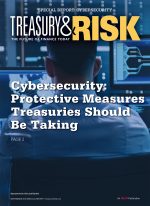 Much has changed since the early 20th century bank robber Willie Sutton, when asked why he chose his targets, reportedly said, “Because that's where the money is.” Criminals are now using tools Sutton couldn't have dreamed of, but their philosophy in choosing targets remains pretty true to his.
Much has changed since the early 20th century bank robber Willie Sutton, when asked why he chose his targets, reportedly said, “Because that's where the money is.” Criminals are now using tools Sutton couldn't have dreamed of, but their philosophy in choosing targets remains pretty true to his.
Many attacks are now perpetrated online, alarming growth in volume and sophistication over the past two years. Equally distressing is the range of perpetrators, from conventional hackers and disgruntled employees to well-funded nation-states, terrorist organizations, and criminal groups. Their top target in many attacks: corporate treasury.
That's where the corporate money is. But some hackers that target treasury have more in their sights than direct theft of company funds. Treasury systems are repositories of sensitive data that can be stolen. Crucial financial systems also can be shut down, either for ransom or to promote a geopolitical agenda. Aside from the financial costs of these disruptions, companies confront the risk of serious reputational damage, which may have a lingering business impact.
While many corporate treasuries have thoughtful measures in place to ward off known forms of malware, it's tomorrow's (currently unknown) malware that gives deep pause for information security experts. Hackers and fraudsters are in the business of inventing new types of ever-more-innovative cyberattacks, their methods continually evolving to achieve specific aims.
“Cybercriminals consider corporate treasury – due to its mission-critical function of managing the flow of funds – to be a high-value target.”
– Rajesh Shenoy, Global Head of Digital Security, Treasury and Trade Solutions, Citi
In this work, corporate treasury is in the crosshairs. “Cybercriminals consider corporate treasury—due to its mission-critical function of managing the flow of funds—to be a high-value target,” says Rajesh Shenoy, global head of Digital Security, Treasury and Trade Solutions at Citi. “Consequently, treasuries must do all they can to make their operations less of a target by hardening their systems, processes, and procedures to be less susceptible to a cyber event taking place.”
Payments Fraud Continues to Grow
Payments fraud is a key cyber event that treasuries need to protect against. According to the 2018 Payments Fraud Survey of nearly 700 treasury and finance professionals conducted by the Association for Financial Professionals (AFP), a record 78 percent of treasury organizations were hit with payments fraud in 2017.
“It is alarming that the rate of payments fraud has reached a record high despite repeated warnings,” says Jim Kaitz, AFP's president and CEO. “In addition to being extremely vigilant, treasury and finance professionals will need to anticipate [such] scams and be prepared to deter these attacks.”
A key method of perpetrating payments fraud is business email compromise, whereby an attacker gains access to a corporate email account and spoofs the owner's identity to defraud the company—or its employees, customers, or partners—of money.
Business email compromise scams are among the top fraud threats to corporate treasury and finance, with both the frequency of attempts and the total dollar amounts stolen increasing in recent months—dramatically in some cases. The AFP survey indicates that 77 percent of organizations experienced at least one such attack in 2017. More than half the scams (54 percent) targeted wire payments, followed by checks at 34 percent. A typical ruse involves persuading an employee to send a fraudulent invoice for processing by accounts payable, which unknowingly makes the payment to a bank account controlled by the fraudster.
Shenoy agrees with these findings. “Increasingly, a combination of technology and human elements looking to compromise people, manipulating them to take specific actions for what they believe are authentic business purposes,” he says. “Most people think they would spot such charades, but the truth is they are extremely well thought out and crafted.”
Data Breaches a Major Concern
Although business email compromises make up the bulk of payments fraud schemes, other treasury-focused cyberattacks are predicated on stealing valuable data—typically including the names, addresses, bank account information, and bank statement details of vendors, partnering organizations, employees, customers, and other payers and payees. Once they've stolen personal data, cyber thieves hold it for ransom or sell it directly on the murky underground forums populating the dark web.
According to Dark Web News, bank accounts hold more value than other forms of identity in that world. A $2,000
account balance, for instance, could sell for about a tenth of its value, or $200. Multiply this figure by hundreds or thousands of accounts, and the incentive for identity theft increases exponentially.
Corporate treasuries that suffer a successful attack resulting in a breach of personal data can incur stiff penalties. The new General Data Protection Regulation (GDPR) in the European Union, for example, imposes substantial fines on companies for noncompliance—up to 20 million euros or 4 percent of global annual turnover, whichever is higher. All companies that do business in the EU must comply with the regulation.
“In and organization of 25,000 people you might have 10 or 15 people within treasury, narrowing a hacker's ability to perpetrate a phishing attack. At the same time, thought, this makes it easier to seek out the most vulnerable target.”
– Bob Stark, Vice President of Strategy, Kyriba
Other cyberattacks, like ransomware, involve encrypting a treasury system to curtail its service until a ransom is paid. And paying the money doesn't guarantee the company's desired outcome. “In Eastern Europe, many organizations paid the ransom to have their systems decrypted and unlocked, but in some cases they nonetheless remained locked,” says Shenoy.
He's referring to malware called NotPetya, which was blamed for disrupting business operations at shipping ports, advertising agencies, law firms, and retail outlets in 2017. Once inside these organizations' networks, the malware destroyed the infected machines' file systems. The goal was not financial gain; rather, it was geopolitically motivated, designed to completely shut down corporate networks for purely malicious reasons.
The attacks were followed by the similar Bad Rabbit malware that infected the networks and systems of several news media organizations in Russia, Ukraine, and Turkey. Hackers demanded payment in bitcoin to decrypt the fi les they had encrypted, then neglected to make good on some of their promises. The malware was eventually decrypted when keys to unlock it were provided by Internet security firms.
Hacker Sophistication Requires Employee Vigilance
How often do cyberattacks hit corporate treasuries? It depends. “For the most part, treasuries are attacked on an infrequent basis, but in some large organizations, these attempts are fairly common, as many as multiple times a day,” says Bob Stark, vice president of strategy at Kyriba, a provider of cloud-based treasury management software systems. “A small company, on the other hand, might be attacked once or twice a year.”
There are no current statistics on the aggregate number of successful cyberattacks against corporate treasuries or the total cost of these crimes. For security purposes, many treasuries prefer to stay tight-lipped on the subject. However, the interviewees agree that the risk and financial impact are substantial. Based on anecdotal evidence, losses are likely in the tens of millions of dollars, if not more.
“The potential losses are huge,” a 2017 report produced by the Economist Intelligence Unit (EIU) states. “Hackers infiltrating individual companies have stolen tens of millions of dollars in a single attack. The stock price of breached companies falls, and CEOs are sacked. Data losses create reputational damage and lawsuits from inside and outside the company. Even mergers and acquisitions can be derailed or altered in value to the tune of hundreds of millions of dollars.”
Today's cyberattackers differ from previous generations in their meticulous planning. Criminals undertake copious research and trial-and-error experimentation in plotting the crimes before they execute. “Sophisticated cybercriminals use social engineering and inside information gleaned from lengthy reconnaissance within a given company's systems to execute high-value thefts,” the EIU report states.
Nevertheless, many treasurers believe their companies are well-protected. To a certain extent they are—most organizations have undertaken basic security procedures like installing software system updates, limiting network and data access, and incorporating penetration testing to spot vulnerabilities. The Achilles heel in many cases is people. Even after small doses of cybersecurity training, treasury, finance, and accounts payable staff may fail to recognize (or respond effectively to) scams that use social engineering to target the right people with the right message for a successful attack. Thus, business email compromise remains the primary attack vector used to gain unauthorized access to treasury systems.
“The biggest threat to corporate treasury cybersecurity is often staff complacency,” according to a report on treasury payment fraud by research firm IDC. “Cybersecurity within the treasury department is as much, or perhaps even more, about the people.”
A common example of a business email compromise attack that utilizes social engineering is the so-called “CEO fraud,” in which a hacker, impersonating the company's CEO or other senior executives, emails a specific employee asking him or her to make an urgent, confidential payment on the executive's behalf. In some cases, the hacker follows up with a phone call to the person, who has been carefully selected as having personality traits that suggest he or she is unlikely to question authority.
Before an employee receives such an email, the scammer does a lot of research. Typically, these scams are perpetrated by someone with inside knowledge of the company, its business procedures, and key people, which enables the scammer to augment the appearance of legitimacy. These requests also emphasize the time sensitive nature of the payment, which pressures the employee to act immediately and discourages him or her from seeking to substantiate the request with another senior executive before initiating payment.
If there is a silver lining here, it is that the relatively small number of treasury employees limits the available pool of people for scammers to target. “In an organization of 25,000 people you might have 10 or 15 people within treasury, narrowing a hacker's ability to perpetrate a phishing attack,” says Stark. “At the same time, though this makes it easier to seek out the most vulnerable target.”
How to Mount a Defense
Treasury organizations are extremely concerned about the risk of payments fraud. “This is not a question of 'Will this happen?'—it's a question of when,” says Shenoy. “The majority of treasury professionals have seen payments fraud and other types of cyberattacks. Such attacks are increasing in number and sophistication. Regrettably, there is no silver bullet to stop all attacks at once.”
Studies back him up. An overwhelming 84 percent of corporate treasury groups believe the threat of cyber fraud has increased over the past year, according to a 2018 survey of more than 300 treasury professionals by consultancy Strategic Treasurer. “Fraud continues to be at the forefront of practitioners' minds, and security remains a top priority for treasury in 2018,” the report states. “Fraudulent techniques such as business email compromise and ransomware have become the norm.”
Whereas only 8 percent of respondents had experienced a ransomware attack in 2017, 25 percent had experienced at least one such event in 2018, a more than 300 percent year-over-year increase. Additionally, one-third of the respondents said they were not sure of the source of the attack—whether, for example, it originated internally or externally, and whether it involved a criminal working solo or a group.
Despite the extraordinary increase in cyber fraud threats, only one-quarter of corporate treasuries in the survey indicated that they have increased their spending on payments fraud security and controls in the past three years. Those that have primarily targeted treasury payment controls, reconciliation features, account-level controls, and fraud monitoring. The report concluded that many practitioners had inadequate security controls, unassigned fraud management responsibilities, a piecemeal approach to security, and poor visibility into transactions.
The latter finding resonates loudly with Stark. “Organizations continue to rely on human eyes to enforce payment policies,” he says. “People can make mistakes, especially as they take on more responsibilities and have to review more data, or match payments against more fraud scenarios.”
Building Resilience
In many corporate treasuries, the level of preparedness to identify and respond to future payments fraud schemes is unsettling. Fortunately, several well-known best practices can help treasury teams mount a stronger defense against cyberattacks.
The first step is to identify major vulnerabilities in the corporate network and treasury-related systems. Through in-depth risk assessments the company's information security team and/or an external cyber-risk consultant can ferret out weaknesses in the treasury organization's critical business processes, data assets, and systems, as well as the integration points between systems.
Citi's Treasury and Trade Solutions team utilizes regular cybersecurity reviews. “It is critical to have the right subject matter expertise to pinpoint vulnerabilities and know how to effectively respond,” Shenoy says. “We work hand-in-hand with teams across the organization to safeguard our most important data on a day-to-day basis. Our information security team also analyzes recent cyber events as well as real-time threat intelligence to assess potential impact to the treasury system and our processes.”
Based in part on these analyses, Citi recently strengthened the security of its client-facing online platform. Customers using its banking services app can utilize a software token that generates a one-time password on their mobile device for authentication purposes. “We've also put in place invisible controls that the bad guys are unaware of, using advanced analytics and machine learning technology to help identify a customer's normal patterns against what appear to be anomalies,” Shenoy says.
When unusual activity occurs, such as a customer logging onto the platform at an unusual hour or from an odd location, the system sends up a red flag. “We're not expecting to catch 100 percent of fraudulent activities, but we'll expect to catch more of them,” Shenoy says.
Stark agrees. “AI-based payment fraud detection is increasing in sophistication, with complex algorithms now able to detect custom fraud scenarios in real-time,” he says. “In some cases, these tools are built into payment workflows, building a better line of defense.”
Another best practice is to conduct routine penetration tests to uncover weaknesses in the cyber-defense methods of the treasury organization, suppliers, and partnering organizations. The EIU report indicates that 92 percent of respondents to that survey conduct internal penetration testing, but only 33 percent apply the same testing to their suppliers.
Moreover, 19 percent of treasury departments fail to check their suppliers' identity authentication processes or evaluate whether suppliers have secure email systems for protecting confidential information. “Our research found serious gaps in corporate defense, including vulnerabilities hidden within third parties and their subcontractors,” the EIU report states.
Stark affirms that third parties are a chink in the armor. “We find it highly advisable for the CISO or someone in information security to require suppliers to fill out a lengthy questionnaire asking them about their IT security processes,” he says. “This way, you're able to compare each supplier against other suppliers in terms of their cyber-risk defenses and response procedures. The more vulnerable suppliers become that much clearer.”
Workflows and Controls
Another smart tactic is to standardize and document payment approval workfl ows and other treasury processes, and to appraise the effectiveness of these controls on a regular basis. “There are information security standards like ISO 27001 and third-party audits like SOC 1, 2, and 3 reports that treasury technology vendors should adhere to,” Stark explains.
Two other defensive processes are to encrypt all treasury data in transit and at rest, and to segregate duties within the treasury organization to reduce the possibility of internal fraud. With regard to the latter tactic, only certain people should have access to specific types of payment data.
“You want to separate the duties between the payment initiator, the payment approver, and the reviewer of a detected payment,” says Stark. “It's best to designate these reviewers by payment rule and specific payment scenarios. For example, a decision might be made for payments under $1 million to be reviewed by the treasury manager, whereas payments over this amount would be sent to the treasurer for review.”
Yet another best practice is to use a security incident and event management (SIEM) system. The InfoSec Institute describes SIEM systems as offering a “real-time analysis of a security alert generated by operational systems, applications, network hardware, and databases.”
“If you don't have a SIEM system and you're hacked, you're likely to be stuck wondering too long about what you need to do next,” says Stark. “The longer you wait, the worse the situation can become. And if the attempt is successful, it is typically followed by additional attacks.” He pointed out that Kyriba's cloud-based treasury solution comes equipped with a SIEM system.
Help Is Here
Many companies that provide products or services to corporate treasury functions are offering online resources that help customers with cyberattack planning, management, mitigation, and response. For instance, both Kyriba and the Treasury and Trade Solutions group at Citi have created guides to help detect various scams.
Corporate treasury teams will become increasingly effective at discerning and defending against cyberattacks as cutting-edge technologies become more widely available. “Later this year, we plan to roll out tools that have the potential to detect anomalies in how users navigate applications using their computer mouse, arrow keys, and the scroll bar,” says Shenoy. “Such behind-the-scenes tools can tell us things we couldn't guess at before.”
Just in time, too. “Cyberattacks are becoming more sophisticated, but we're becoming more sophisticated, too,” says Stark. “Our capabilities are constantly improving.”
Also from the September 2018 Special Report
SPONSORED STATEMENT: Treasury Fights Back: Latest Trends in Combating Cybersecurity Threats
© Touchpoint Markets, All Rights Reserved. Request academic re-use from www.copyright.com. All other uses, submit a request to [email protected]. For more inforrmation visit Asset & Logo Licensing.




